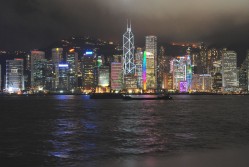
As far as foreigners who travel in Hong Kong are concerned, the special administrative region is divided into two sections: Kowloon and Hong Kong Island, separated by Hong Kong harbor. If you’re backpackers in the midst of Hong Kong travel, you are probably staying in a Kowloon neighborhood such Tsim Sha Tsui or Mong Kong — Hong Kong island is decidedly more upmarket.
This doesn’t mean you can’t enjoy Hong Kong island while you travel in Hong Kong, however. Once you take the Star Ferry across the harbor , you can explore Hong Kong island almost completely free of charge.

Use the Star Ferry to travel in Hong Kong
Ferry Ports in Hong Kong
Although Hong Kong has a very sophisticated metro system, ferries crossing the harbor are still an important means of traveling between Hong Kong Island and Kowloon. Traditional tourist wisdom might steer you away from boarding them, but no visit to Hong Kong is complete without taking in its stunning skyline from out on the water.
The Star Ferry is the cheapest way to travel in Hong: A one-way ticket between Kowloon Hong Kong Island runs just HK$2,50, or less than 50 cents. (By comparison, a ticket for the same journey on the Hong Kong metro costs you between HK$8-10.) The journey lasts about 15 minutes each way, plenty of time to take in Hong Kong’s stunning urban scenery. The ferry drops you at whichever of the two ports you select when you board in Kowloon: Sheung Wan or Wan Chai.
Beyond its cheap cost and beautiful views, The Star Ferry, whose massive green and white vessels hearken back to the Hong Kong’s British past, is also a great means of travel in Hong Kong because of the people watching people watching. Indeed, its cheap price and convenient location makes it a popular choice for Hong Kong travel among locals, expats and tourists from all parts of the world alike.

Stairs take you to the Hong Kong Mid-Levels
Hong Kong Mid-Levels
Where you begin your travel in Hong Kong island is, ultimately, unimportant. Sheung Wan is primary residential whereas Wan Chai is home to skyscrapers Hong Kong’s banking nucleus. If you walk far enough into either of these areas, you’ll come upon stairs or escalators that lead to an aptly-named part of Hong Kong island known as the “Mid-Levels.”
The Mid-Levels don’t offer a whole lot in the way of activities or entertainment but rather, the opportunity to take in an increasingly more panoramic view of Hong Kong. The staircases are seemingly vertical and seem to go on forever, so if you don’t like walking, it might be best to find one of the escalators that leads up to the Mid-Levels.
The Mid-Levels are high enough to provide a pleasing view of the lower-lying regions below, but densely packed enough to where you’re still very much in the thick of Hong Kong. The height of the skyscrapers coupled with their slim, square footprints is something of a New York-San Francisco hybrid.

Is the Hong Kong Zoo cool or cruel? You decide.
Hong Kong Zoological and Botanical Gardens
You eventually reach a point where you can no longer continue climbing higher through the mid-levels. This isn’t because the elevation stops increasing but rather, because there are no more staircases and no more roads heading up the hill.
Instead head east, which eventually takes you to the set of staircases you can use to get descend back into the Central Hong Kong. Don’t go back down before you visit the Hong Kong Zoological and Botanical Gardens. Opened in 1862 and continuously operating ever since, the Island’s only zoo gives a new meaning to the phrase “urban jungle,” with wild animals such as orangutans and lemurs making their home within the thick greenery of the Hong Kong Mid-Levels.
For some, the zoo may seem a smart, creative integration of the wild with civilization. Others, however, may see the zoo as barbaric, its animals enclosed in confining, cruel wire cages. No matter your view on the zoo, one thing is for sure: As is the case with countless other aspects of greater Hong Kong surrounding it, there is no place in the world quite like it.

Hong Kong as seen from the Peak
The Peak
After you finish up at the zoo, you can head back down into Hong Kong using those staircases I mentioned in the last section, or you can continue walking eastward until you begin seeing signage for something called “The Peak.” Not surprisingly, the Peak is a Hong Kong viewpoint, one you must take a tram to reach. The cost is HK$40 return, or about $5.
In the past, as you’ll see looking at the signs you pass on the way up, local Chinese men would carry fat, wealthy Brits up the peak in “sedan chairs” that invoke Egypt more than Asia. Once you reach the top, performers are able to carry you in a sedan chair for a few minutes if you so choose.
The Peak makes for a fitting close to your Hong Kong island walking tour, whether you finish at mid-day or in time to watch the sun set in the evening.

Robert Schrader is a travel writer and photographer who’s been roaming the world independently since 2005, writing for publications such as “CNNGo” and “Shanghaiist” along the way. His blog, Leave Your Daily Hell, provides a mix of travel advice, destination guides and personal essays covering the more esoteric aspects of life as a traveler.








